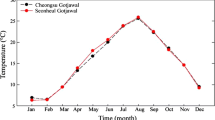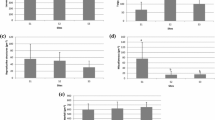Abstract
Litter plays a crucial role in forest ecosystem functioning as its production and decomposition govern the pools and fluxes of forest nutrient cycling. The release of nutrients through litterfall and decomposition influences forest productivity. Therefore, these two factors are considered to be important indicators of forest ecosystem health. Such processes vary across different ecosystem types because of natural as well as anthropogenic factors. Hence, studying such processes would help in better understanding and management of forest ecosystems. Litter production and decomposition rates between a broadleaved and a coniferous forest ecosystem of Meghalaya in Northeast India were compared. We selected six subtropical broadleaved forest stands in Muthlong, Ialong, Nongbah, Mukhla, Nongkrem and Mawnai, and six adjacent coniferous forest stands dominated by pine. We estimated leaf litter production, decomposition and nutrient release, and analyzed the nitrogen and phosphorus contents in the litter of both the forest types. The study revealed that litter production and decomposition rates, and the litter nitrogen and phosphorous contents were significantly higher in the broadleaved forest compared to the pine forest. The variability in the litter characteristics was greater in the broadleaved forest compared to the coniferous forest indicating that the former is functionally more dynamic than the latter. Such dynamism in the broadleaved forest could be an important factor for providing greater ecological services compared to the coniferous forest, which nevertheless requires an in-depth study.






Similar content being viewed by others
References
Arunachalam A, Arunachalam KM, Pandey HN, Tripathi RS (1998) Fine litterfall and nutrient dynamics during forest regrowth in the humid subtropics of north-eastern India. For Ecol Manag 110:209–219
Berg B (2000) Litter decomposition and organic matter turnover in northern forest soils. For Ecol Manag 133:13–22
Blair JM (1988) Nutrient release from decomposing foliar litter of three tree species with special reference to calcium, magnesium and potassium dynamics. Plant Soil 110:49–55
Chapman SK, Koch GW (2007) What type of diversity yields synergy during mixed litter decomposition in a natural forest ecosystem? Plant Soil 299:153–162
Gairola S, Rawal RS, Dhar U (2009) Patterns of litterfall and return of nutrients across anthropogenic disturbance gradients in three subalpine forests of west Himalaya, India. J For Res 14:73–80
George SJ, Kumar BM (1998) Litter dynamics and cumulative soil fertility changes in silvopastoral systems of a humid tropical region in central Kerala, India. Int Tree Crops J 9:267–282
Gilbert O, Bocock KL (1960) Changes in leaf litter when placed on the surface of soils with contrasting humus types: II. Changes in the nitrogen content of oak and ash leaf litter. J Soil Sci 11:10–19
Haase R (1999) Litterfall and nutrient return in seasonally flooded and non-flooded forest of the Pantanal, MatoGrosso, Brazil. For Ecol Manag 117:129–147
Hobbie SE, Reich PB, Oleksyn J, Ogdahl M, Zytkowiak R, Hale C, Karolewski P (2006) Tree species effects on decomposition and forest floor dynamics in a common garden. Ecology 87:2288–2297
Isaac SR, Nair MA (2005) Biodegradation of leaf litters in the warm humid tropics of Kerala, India. Soil Biol Biochem 37:1656–1664
Jamaludheen V, Kumar BM (1999) Litter of multipurpose trees in Kerala, India: variations in the amount, quality, decay rates and release of nutrients. For Ecol Manag 115:1–11
Joly FX, Milcu A, Scherer-Lorenzen M, Jean LK, Bussotti F, Dawud SM, Müller S, Pollastrini M, Raulund-Rasmussen K, Vesterdal L, Hättenschwiler S (2017) Tree species diversity affects decomposition through modified micro-environmental conditions across European forests. New Phytol 214:1281–1293
Kamei J, Barik SK, Pandey HN (2009) Interspecific variation in leaf litter production, decomposition, and nitrogen and phosphorus loss from decomposing leaves in a humid subtropical forest ecosystem of northeastern India. Can J For Res 39:1797–1805
Kavvadias VA, Alifragis D, Tsiontsis A, Brofas G, Stamatelos G (2001) Litterfall, litter accumulation and litter decomposition rates in four forest ecosystems in northern Greece. For Ecol Manag 144:113–127
Khiewtam RS, Ramakrishnan PS (1993) Litter and fine root dynamics of a relict sacred grove forest at Cherrapunji in north-eastern India. For Ecol Manag 60:327–344
Knops JMH, Wedin D, Tilman D (2001) Biodiversity and decomposition in experimental grassland ecosystems. Oecologia 126:429–433
Krishna MP, Mohan M (2017) Litter decomposition in forest ecosystems: a review. Energy Ecol Environ 2:236–249
Leon JD, Osorio NW (2014) Role of litter turnover in soil quality in tropical degraded lands of Colombia. Sci World J 2014:11 (article ID 693981)
Liski J, Palosuo T, Peltoniemi M, Sievanen R (2005) Carbon and decomposition model Yasso for forest soils. Ecol Model 189:168–182
Mcadam JH, Sibbald AR, Teklehaimanot Z, Eason WR (2007) Developing silvopastoral systems and their effects on diversity of fauna. Agrofor Syst 70:81–89
Moraes R, Delitti WBC, Struffaldi-De Vuono Y (1999) Litterfall and litter nutrient content in two Brazilian Tropical Forests. Braz J Bot 22:09–16
Neumann M, Ukonmaanaho L, Johnson J, Benham S, Vesterdal L, Novotný R, Verstraeten A, Lundin L, Thimonier A, Michopoulos P, Hasenauer H (2018) Quantifying carbon and nutrient input from litterfall in European forests using field observations and modeling. Glob Biogeochem Cycles 32:784–798
Odiwe AI, Muoghalu JI (2003) Litterfall dynamics and forest floor litter as influenced by fire in a secondary lowland rain forest in Nigeria. J Trop Ecol 44:243–251
Olson JS (1963) Energy storage and the balance of producers and decomposers in ecological systems. Ecology 44:322–331
Osono T, Takeda H (2001) Organic chemical and nutrient dynamics in decomposing beech leaf litter in relation to fungal ingrowth and succession during 3-year decomposition processes in a cool temperate deciduous forest in Japan. Ecol Res 16:649–670
Osono T, Takeda H (2004) Accumulation and release of nitrogen and phosphorus in relation to lignin decomposition in leaf litter of 14 tree species. Ecol Res 19:593–602
Pragasan LA, Parthasarathy N (2005) Litter production in tropical dry evergreen forests of south India in relation to season, plant life-forms and physiognomic groups. Curr Sci 88:1255–1263
Prescott CE, Zabek LM, Staley CL, Kabzems R (2000) Decomposition of broadleaf and needle litter in forests of British Columbia: influences of litter type, forest type, and litter mixtures. Can J For Res 30:1742–1750
Ramachandra SH, Proctor J (1994) Litterfall and nutrient cycling in four rain forests in the Sringeri area of the Indian Western Ghats. Glob Ecol Biogeogr Lett 4:155–165
Ranger J, Gérard F, Lindemann M, Gelhaye D, Gelhaye L (2003) Dynamics of litterfall in a chronosequence of Douglas-fir (Pseudotsugamenziesii Franco) stands in the Beaujolais mounts (France). Ann For Sci 60:475–488
Reiners WA, Reiners NM (1970) Energy and nutrient dynamics of forest floors in three Minnesota forests. J Ecol 58:497–519
Santa Regina I, Tarazona T (2001) Nutrient cycling in a natural beech forest and adjacent planted pine in northern Spain. Forestry 74:11–28
Sundarapandian SM, Swamy PS (1999) Litter production and leaf-litter decomposition of selected tree species in tropical forests at Kodayar in the Western Ghats, India. For Ecol Manag 123:231–244
Swift MJ, Heal OW, Anderson JM (1979) Decomposition in terrestrial ecosystems. In: Anderson DJ, Greig-smith P, Pitelka FA (eds) Studies in ecology. University of California Press, Berkeley, pp 167–219
Tanner EVJ, Vitousek PM, Cuevas E (1998) Experimental investigation of nutrient limitation of forest growth on wet tropical mountains. Ecology 79:10–22
Tripathi SK, Singh KP (1992) Nutrient immobilization and release patterns during plant decomposition in a dry tropical bamboo savanna, India. Biol Fertil Soils 14:191–199
Trofymow JA, Moore TR, Titus B, Prescott C (2002) Rates of litter decomposition over 6 years in Canadian forests: influence of litter quality and climate. Can J For Res 32:789–804
Vogt KA, Grier CC, Vogt DJ (1986) Production, turnover and nutrient dynamics of above- and below-ground detritus of the world forests. Adv Ecol Res 15:303–377
Wedderburn ME, Carter J (1999) Litter decomposition by four functional tree types for use in silvopastoral systems. Soil Biol Biochem 31:455–461
Weerakkody J, Parkinson D (2006) Input, accumulation and turnover of organic matter, nitrogen and phosphorus in surface organic layers of an upper montane rainforest in Sri Lanka. Pedobiologia 50:377–383
Weltzin JF, Keller JK, Bridgham SD, Paster J, Allen BP, Chen J (2005) Litter controls plant community composition in a northern fen. Oikos 110:537–546
Winkler R, Boon S, Zimonick B, Baleshta K (2010) Assessing the effects of postpine beetle forest litter on snow albedo. Hydrol Process 24:803–812
Xu XN, Hirata E (2002) Forest floor mass and litterfall in Pinus luchuensis plantations with and without broad-leaved trees. For Ecol Manag 157:165–173
Xu X, Tokashiki Y, Hirata E, Enoki T, Nogami K (2000) Ecological studies on subtropical evergreen broad-leaved forest in Okinawa, Japan: litter production and nutrient input. J For Res 5:151–156
Yang Y, Guo J, Chen G, Xie J, Cai L, Lin P (2004) Litterfall, nutrient return, and leaf-litter decomposition in four plantations compared with a natural forest in subtropical China. Ann For Sci 61:465–476
Yang YS, Guo JF, Chen GS, Xie JS, Gao R, Li Z, Jin Z (2005) Litter production, seasonal pattern and nutrient return in seven natural forests compared with a plantation in southern China. Forestry 78:403–415
Acknowledgements
The authors thank the Ministry of Environment, Forests, and Climate Change (MoEF & CC), Government of India for providing financial assistance under the All India Coordinated Project on Sacred grove ecosystem services of Meghalaya. The first author is also grateful to the Ministry of Tribal Affairs for providing financial assistance in the form of a National Fellowship for the Scheduled Tribes (NFST, File: F1-17.1/2016-17/NFST-2015-17-ST-MEG-2987). The authors also thank the Coordinator of CAS, Department of Botany, and Head, Department of Botany, NEHU, Shillong for the facilities created under the Centre for Advanced Studies (CAS) in Botany program, which were utilized for this research. Thanks are also due to the Raij, Lyngdoh and Dolloi in charge of the respective six sacred forests for granting permission to carry out the research work in the forests under their jurisdiction.
Author information
Authors and Affiliations
Corresponding author
Rights and permissions
About this article
Cite this article
Nonghuloo, I.M., Kharbhih, S., Suchiang, B.R. et al. Production, decomposition and nutrient contents of litter in subtropical broadleaved forest surpass those in coniferous forest, Meghalaya. Trop Ecol 61, 5–12 (2020). https://doi.org/10.1007/s42965-020-00065-x
Received:
Revised:
Accepted:
Published:
Issue Date:
DOI: https://doi.org/10.1007/s42965-020-00065-x




